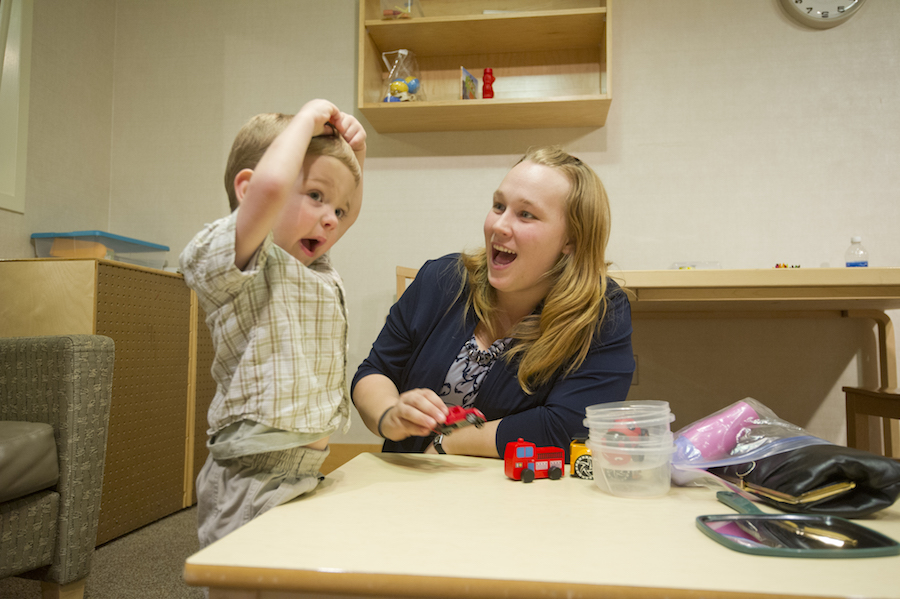
The Autism Phenome Project at the UC Davis MIND Institute studies the biological phenotypes of autism
Over the last 20 years, Autism Spectrum Disorder has become the fastest growing developmental disorder, presently affecting 1 in 68 children.
The UC Davis MIND Institute’s Autism Phenome Project (APP) studies the phenotypes of autism for a more accurate diagnosis and treatment plan. The APP works closely with participants and their families to collect data through medical history interviews and exams, as well as provide a blood sample for immune and genetic testing. In addition, an MRI is performed on the child to monitor brain activity while he or she is asleep.
“Recruitment of families happens through the MIND Institute Database. Families interested provide data and then we contact them,” said Deana Li, APP project coordinator and team member. “We also recruit in the community by attending local events like the Autism Walk to spread awareness about our study.”
According to Li, the majority of participating families come from California, though some travel from out of state to be a part of the study.
“This is an awesome project. The information that has been secured is important,” said Dr. Mary Steinfeld M.D., a pediatrician who provides evaluations and medical exams for the participants.
This project has already revealed three key discoveries: girls with autism have different brain development than boys, the immune system of some children with autism differs from their parents and that subsets of children with autism have specific patterns of blood metabolites that may be predictor of this developmental disorder.
The APP incorporates three different subgroups aimed at identifying certain phenotypes within autism: New APP, GAIN and APP Middle Childhood. New APP enrolls families with boys diagnosed between 2 to 3½ years of age, the GAIN study is for families with girls diagnosed between 2 to 3 ½ years of age and finally the APP Middle Childhood with participants aged between 9 to 12 years old.
“We were not able to enroll as many girls as boys and saw the need to increase girl participants,” Li said, regarding the creation of the GAIN study, the largest study of preschool-aged girls with Autism Spectrum Disorder.
There are differences between girls and boys with autism, including a higher prevalence in boys
“The ratio of autism diagnosis if a girl has an intellectual disability is 2 boys to 1 girl. A autism diagnosis with average IQ is 6 boys to 1 girl,” said Dr. Breanna Winder-Patel, a clinical psychologist who administers the behavioral assessments on participants. “Girls are getting diagnosed later than boys, and we are researching to find out why.”
The creation of the APP Middle Childhood was developed as the original participants of 2 to 3 ½ years of age entered elementary school age. APP Middle Childhood looks to collect data and analyze cognitive processes, attention, learning, memory and anxiety over age range.
“We want to continue as long as we can with the kids. It is such a unique cohort and we are looking to expand,” Li said.
The MRI performed on the child during sleep is a contributing factor to the longitudinal analysis of this study.
“The MRI study has an 89 percent success rate. There is no sedation involved and parents are likely to participate since it is less invasive. We work very closely with parents to make this happen,” Li said. “They provide us with knowledge of their child’s bedtime procedures so the child is calm, relaxed and sleeping during the scan”
MRIs are extremely loud, but the APP has provided files of practice MRI sounds posted to their website so parents are able to familiarize their child to it beforehand.
“The imaging component allows us to look at early biological and neural predictors of autism. The MRI’s across different time points of a child is key to our longitudinal analysis,” Li said. “[The reason] why we continue to bring back the middle hood patients [is] to do more tests since we have all this data from when they were younger.”
Other components of the longitudinal analysis includes the medical history interviews and exams, as well as studying anxiety disorders.
“I interview the parents to find out how anxiety has impacted these kids. The parents have been wonderful sharing information,” said Dr. Winder-Patel. “The goal is to see if their symptoms have improved or not to when they were younger.”
Over 300 families have participated in the Autism Phenome Project, and it is now the largest study of children with autism in the world.
“The commitment of the parents is incredible because they have to keep coming back for follow-ups. They are generous with their time,” Steinfeld said.
Autism Spectrum Disorder varies from person to person. Because each person with autism is unique, scientists, physicians and psychologists have had difficulties identifying and creating a solution to the disorder.
The APP hopes to continue to recruit more participants and identify subgroups of autism through behavioral and biological data to better understand the disorder.
“Children with autism are delightful and funny. I love interacting with the kids and their families,” Steinfeld said. “I like watching the parents be patient while I talk to the kids. Parents may hear a story from their child a million times but not hear their child tell it to a new person.”
Written by: Shivani Kamal – science@theaggie.org




